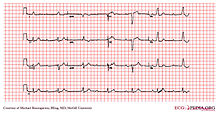
Back عدم تحمل التمرين Arabic Netolerancija na vježbanje BS Intolerancia al ejercicio Spanish 운동 불내성 Korean Träningsintolerans Swedish
| Exercise intolerance | |
|---|---|
| Other names | Exertion intolerance |
 | |
| EKG of a 70-year-old man with exercise intolerance | |
| Specialty | Cardiology, pulmonology, vascular medicine/vascular surgery/phlebology, rheumatology, orthopedics, neurosurgery, neurology; exercise physiology, physical therapy/physiotherapy |
| Symptoms | Dyspnea, chest pain, other pains, fatigue, inappropriate rapid heart rate response to exercise |
| Duration | Variable |
| Causes | Various |
| Risk factors | Multiple, including sedentary lifestyle and low baseline physical activity |
Exercise intolerance is a condition of inability or decreased ability to perform physical exercise at the normally expected level or duration for people of that age, size, sex, and muscle mass.[1] It also includes experiences of unusually severe post-exercise pain, fatigue, nausea, vomiting or other negative effects. Exercise intolerance is not a disease or syndrome in and of itself, but can result from various disorders.
In most cases, the specific reason that exercise is not tolerated is of considerable significance when trying to isolate the cause down to a specific disease. Dysfunctions involving the pulmonary, cardiovascular or neuromuscular systems have been frequently found to be associated with exercise intolerance, with behavioural causes also playing a part.[2]
- ^ Cite error: The named reference
:2was invoked but never defined (see the help page). - ^ Scott Owens, Bernard Gutin (2000). "Exercise Intolerance". Pediatrics in Review. 21 (1): 6–9. doi:10.1542/pir.21-1-6. PMID 10617757. S2CID 39545913. Retrieved 2015-04-17.